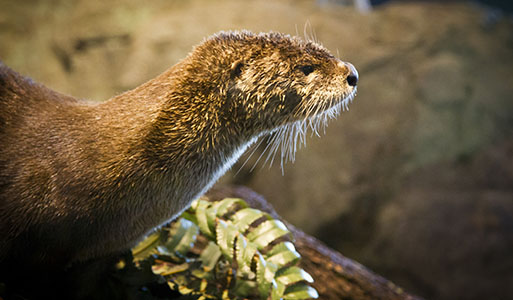Everyone knows that river otters are otterly adorable, but did you know all of the traits and adaptations that make these clever creatures so amazing?

As top predators, river otters are as important to their environment as their habitat is to them. River otter populations and ecosystem health go hand in hand. Photo by Courtney Lauchaire/Aquarium of the Bay
By Mallory Johnson
Published: May, 2015
Everyone knows that river otters are otterly adorable, but did you know all of the traits and adaptations that make these clever creatures so amazing?
- River otters are NOT sea otters. What’s the difference? Among other things, sea otters are marine mammals that live in the salty seawater. River otters are semiaquatic mammals that live in and around rivers. River otters spend about as much time on land as they do in the water, but when they do go swimming, they stick with the fresh water provided by river, lake and estuary ecosystems.
- River otters are part of the weasel family. As a matter of fact, river otters are more closely related to weasels than they are to sea otters.
- River otters are excellent swimmers, thanks to their massive tails and webbed feet, which they use for propulsion. As a matter of fact, river otters can reach up to eight miles per hour in the water.
- River otters have lungs for a life aquatic. A river otter’s right lung is about 20 percent larger than the left, and has four lobes instead of the left’s two. They can hold their breath for up to eight minutes, and they can close their nostrils and ears while under water.
- River otters weigh in at an average of approximately 20 pounds, and they typically measure from 26-42 inches. Bonus fact: a river otter’s tail makes up about a third of its total body length.
- When you’re a river otter, there’s always time for playing. These lively creatures love to play in the snow and among icy and muddy hills. They can often be seen sliding and tobogganing, wrestling and chasing one another.
- River otters have over 58,000 hairs per square centimeter on their body. These semiaquatic mammals are well equipped with water-repellent fur to keep them dry and warm—a useful trait considering how often they get in and out of the water. River otters actually have two layers of fur; the outer layer is longer and helps repel water, while the inner layer is finer and denser and helps provide insulation.
- River otters are top predators in their ecosystems. Favorite foods include crayfish, crabs, fish, frogs and rodents.
As top predators, river otters are as important to their environment as their habitat is to them. River otter populations and ecosystem health go hand in hand. River otters are a good indicator species because they allow us to learn how well restoration efforts are working by monitoring otter populations. As the health of a stream, river or the Bay changes, so does the amount of the otter’s prey. In turn, so does the number of otters. In order to sustain a healthy population of otters, we need to protect and restore their habitat.
Learn more about river otters in person when you visit Aquarium of the Bay’s North American river otter habitat, or by visiting www.aquariumofthebay.org.
Mallory Johnson is the public relations coordinator for Aquarium of the Bay, a nonprofit organization dedicated to protecting, restoring and inspiring the conservation of San Francisco Bay and its watershed.

